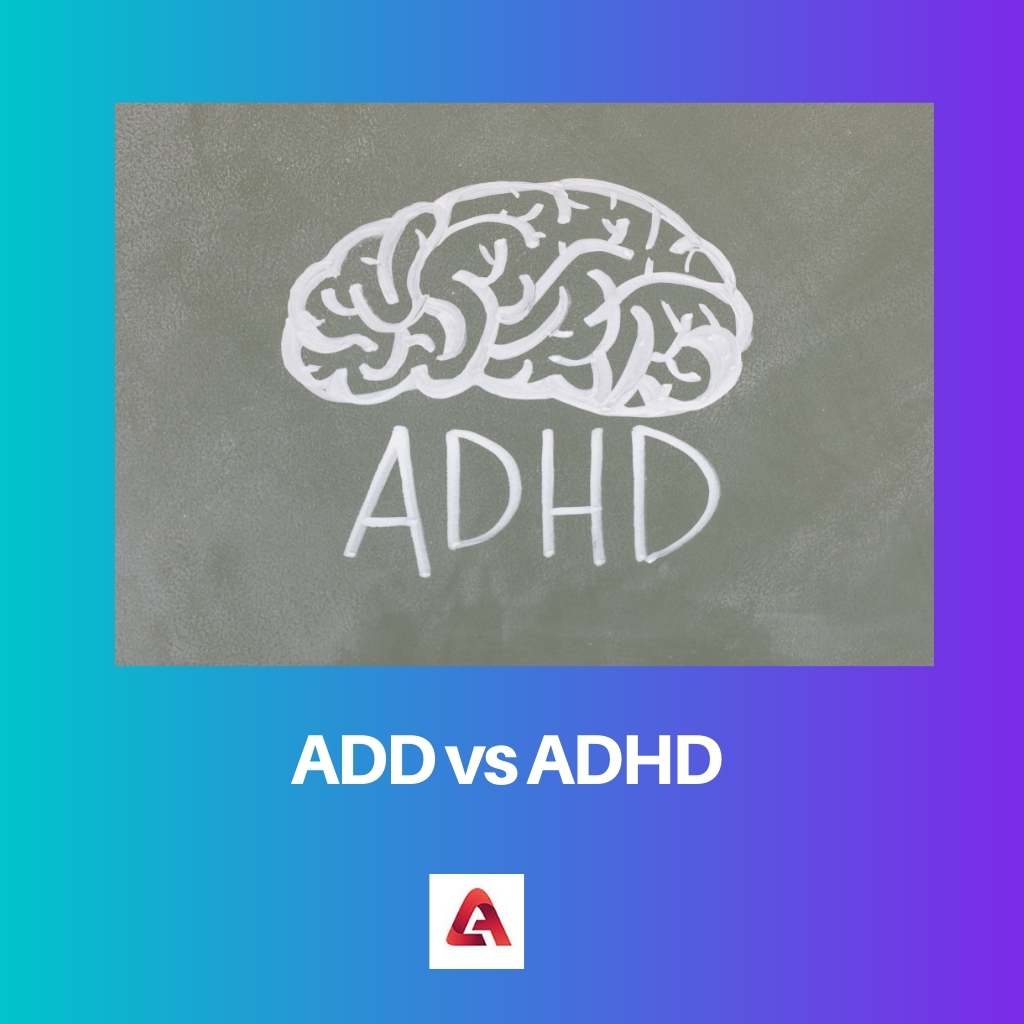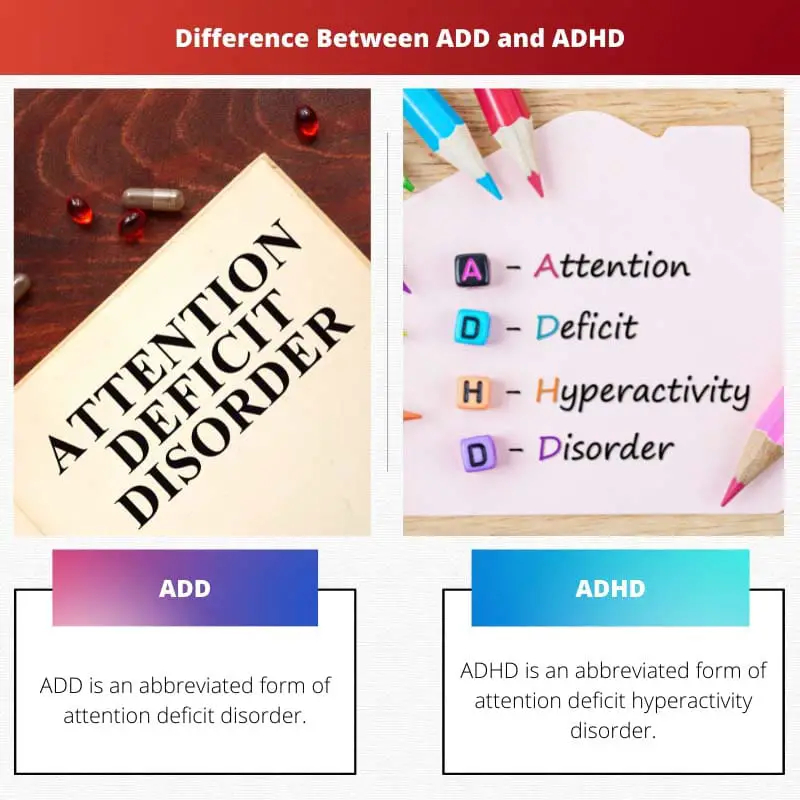With time, people have become more and more attentive and caring towards mental illnesses.
The retention that mental illness is now getting is way more than it was in the past. ADD, and ADHD are two chronic conditions involving many factors, like difficulty in paying attention, impulsiveness, and hyperactivity.
Key Takeaways
- ADD (Attention Deficit Disorder) is characterized by inattention, whereas ADHD (Attention Deficit Hyperactivity Disorder) includes both inattention and hyperactivity/impulsivity symptoms.
- ADD is now considered an outdated term, with ADHD being the current diagnostic label, including three subtypes: predominantly inattentive, predominantly hyperactive-impulsive, and combined presentation.
- Both conditions require a comprehensive evaluation for accurate diagnosis, and treatment options may include medication, therapy, and behavioral interventions.
ADD vs ADHD
The difference between ADD and ADHD is that editing is a condition in which the person shows a lack of paying attention, gets distracted easily and has a poor working memory. On the other hand, it is a condition in which the person leads to hyperactivity as well as impulsivity and requires a lot of attention.

ADD is an abbreviated form of attention deficit disorder.
In this condition, a person faces a neurological condition that involves symptoms like getting distracted easily, not being able to pay attention for a long time, losing track of time, forgetting the schedules, having trouble focusing on work, and struggling with daily life habits.
ADHD is an abbreviated form of attention deficit hyperactivity disorder.
It is considered as a psychological or neurological disorder in which the person faces symptoms like getting random bursts of energy, being very talkative, getting nervous quickly, being fidgety and having a very impulsive nature.
Comparison Table
| Parameters of Comparison | ADD | ADHD |
|---|---|---|
| Full-Form | ADD is Attention Deficit Disorder | ADHD is Attention Deficit Hyperactivity Disorder. |
| Symptoms | Forgetfulness, inactivity, poor attention abilities, unorganised, etc. | Hyperactivity, impulsiveness, outbursts of energy, nervousness, cluttered thoughts, etc. |
| Causes | An imbalance in the brain neurotransmitters results in ADD. | It is a neurological or psychological condition that results due to an imbalance in behavioural neurotransmitters. |
| Subtypes | It doesn’t have subtypes. | It has three subtypes – impulsive ADHD, inattentive ADHD, and a combined form of these two. |
| Treatment | It can be treated with cognitive behavioural therapy. | It can be treated with a lot of attention, care and cognitive behavioural therapy. |
What is ADD?
The acronym for ADD is Attention Deficit Disorder. It is common for people to refer to ADD and ADHD as interchangeable terms, but it’s incorrect since they have many differences.
ADD, or attention deficit disorder, is a psychological or neurological condition that can happen to children and adults.
Although, even a lot of psychologists and Doctors refer to ADD as a term that was used in the olden days and now is referred to as ADHD.
The most common symptom of attention deficit disorder is getting distracted easily, not being able to pay attention and having a hard time keeping track of work.
Many adults with attention deficit disorder have situations like the inability to focus on work, losing track of appointments and scaled use repeatedly, losing track of time and struggling with performing tasks that need attention.
The main difference that can be seen between ADD and ADHD is that it is not characterised by hyperactivity. In order to identify the condition of a DD in children, take a closer look at if they are very shy or reserved, which is not in the case of ADHD.
What is ADHD?
ADHD, or attention deficit hyperactivity disorder, is a condition that is different from ADD.
This condition results in a lot of symptoms varying from having rigorous thoughts, inability to pay attention, being easily distracted, un organisation, severe cases of procrastination, and getting impatient to having sudden outbursts of energy that are hyperactivity.
ADHD even has three subtypes, namely -impulsive ADHD, inattentive ADHD, and the third is a combined form of the two forms as mentioned earlier.
The critical difference between ADD and ADHD is hyperactivity. It is an impulsive condition that is a combined form of inattentiveness, impulsivity and hyperactivity.
Treatment plays a significant role in dealing with the situation of ADHD and getting a grip on the behaviour resulting from this condition.
It is very important to get diagnosed and treated if one has this condition since it has very serious impacts on a person’s social and personal life.
The most fruitful treatment for the management of ADHD is cognitive-behavioural therapy.
This involves a wide range of organised activities, including goal setting, keeping rewards and gifts for achievements, setting rules to follow, and getting a guide to behaviour-modifying techniques.

Main Differences Between ADD and ADHD
- ADD is an abbreviated form of Attention Deficit Disorder, while ADHD refers to Attention Deficit Hyperactivity Disorder.
- Symptoms of Attention Deficit Disorder include forgetfulness, inactivity, un organisation, feeling lazy and unmotivated. Attention Deficit Hyperactivity Disorder symptoms include impulsiveness, nervousness, hyperactivity, sudden outbursts of energy, and wanting attention.
- An imbalance in the brain’s neurotransmitters responsible for behaviour results in ADD and ADHD.
- While ADD does not have any subtypes, on the other hand, ADHD has three subtypes, namely – impulsive ADHD, inattentive ADHD, and a combination of the two.
- ADD does not result in Hyperactivity, whereas ADHD does result in hyperactivity.

- https://books.google.com/books?hl=en&lr=&id=iwmU65RC6x0C&oi=fnd&pg=PA93&dq=difference+between+ADD+and+ADHD&ots=H3T_WFW5_-&sig=5yYdPzSTR-nKBvzWxdZMKSWlZOE
- https://acamh.onlinelibrary.wiley.com/doi/abs/10.1111/j.1469-7610.1995.tb02320.x